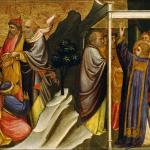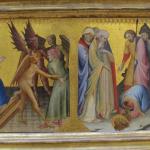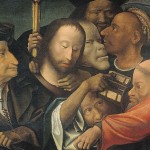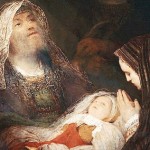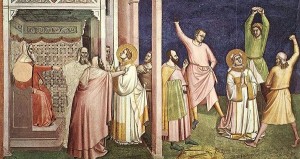 Acts 7:35-53
Acts 7:35-53
In Acts 7:35-53, St. Stephen hones in on his closing arguments. While he begins by acting as a defense attorney, by the end of his sermon he is acting as a prosecutor. It is this shocking reversal that must have caught his audience by surprise and provoked a response. I’m sure Stephen was hoping for a response of repentance, but what he got was exactly what he had just finished warning them about: a rejection of God and His Word and Presence in their lives.
The turning point is verse 51. Immediately before that verse, Stephen had been speaking about Moses and the Law, after which he speaks about the Israelites offering sacrifices to idols. Then there appears to be a respite, in which Stephen turns to the
Temple. His defense ends harmlessly enough with a quotation from Isaiah 66 about how God does not dwell in a temple made with hands.
This in itself might have been offensive to the Jews. But then he turns swiftly to them and makes his true point: “You stiff-necked and uncircumcised in heart and ears! You always resist the Holy Spirit; as your fathers did, so do you!”
But we are not (I hope!) those Jews who rejected God’s messengers and Word and in so doing reject God Himself. So I don’t want us to beat ourselves up, as we attempt to place ourselves in this passage and receive God’s blessing from it.
Instead, I want to meditate on what it would look like from a positive angle: what would it look like in our lives if we received the living oracles of God that were housed in a Temple not made with human hands, instead of rejecting them? This, in fact, is exactly what God has given us. Jesus Christ who is the Word of God is also the Temple made without human hands. But since we are His Body, we, too, have the living oracles of God (the Word of God) housed in the Temple, His Body.
What are we to make of the architecture of the tabernacle and temple? Are they merely aspects of the “ceremonial” law that can be safely dismissed today? We may think so, but Stephen reminds us that Moses was instructed by God Himself to make the tabernacle according to the pattern He had seen (verse 44, and Exodus 25:40 and 26:30). David received precise plans for the Temple given to him by God, plans that were given to him by the Holy Spirit (1 Chronicles 28:12). When David handed these plans to Solomon, he said, “All this the Lord made me understand in writing, by His hand upon me, all the works of these plans” (1 Chronicles 28: 19). These plans for the Temple, the writer of Hebrew teaches us, served as copies and shadows of the heavenly things (Hebrews 8:5).
So what should the Temple look like in our day, to us who have received the true Temple and the New Covenant which is Jesus Christ? It should look like a Temple made of living stones: it should look like the perfect Body of Jesus Christ, His Church.
Each of the elements of the tabernacle or Temple should teach us something about what the Body of Christ, and each individual member, should look like. Remembering the negative example of the Jews who rejected God through rejecting His Word and messengers (which always go together), and the positive commandment to be His Temple, what should we look like?
One of the first things that would strike someone entering the Temple, or even the tabernacle, would be the gold. So much gold. Why bother, for a people who would be wandering for 40 years in the wilderness? Because gold represents the kingship of God, His glory, His beauty, and His worth.
The architecture of the Temple itself suggests that although the whole earth is the Lord’s and He is present in it, it is possible to come closer to Him in deeper ways. Sometimes, we stop to gaze outside the Temple courts, and we are sated with that. Other times we enter into the courts and partake of Him a little more. But shouldn’t there be times, on Sunday mornings and on a daily basis in my house, where I enter the Holy of Holies to spend time with Him Who Is the High Priest, the Sacrifice, and the Temple?
What else do we see in this Temple, this house of God, to which God Himself has called us with His trumpet voice? In the courtyard, I see an altar of burnt offering. What has that to do with me? I am to offer myself today as a living sacrifice to God, joining with the sacrifice of Jesus Christ, whose sacrifice makes mine acceptable.
Going a little further, I notice the bronze laver. What has that to do with me? It reminds me that I must enter into His covenant on the terms that He has decreed. I must be baptized for the remission of sins (Peter’s Pentecostal sermon, Acts 2:38). I must have my sins washed away by the blood of the Lamb offered on the altar of burnt offering that was Calvary and Golgotha. I must seek repentance and the washing away of my sins on a daily basis as well.
And now God invites me in closer to Him, and what do I see? I see the Holy Place. It is lit by the golden lampstand, for God is Light. In His light, I see light, and I am to be light, not only in His presence but so that I may take that light out of the Holy Place and into the world. This light must be burning at all times, for I am a priest and that is my duty.
Across from the lampstand is the Table of Showbread. Here, too, is Christ, who is not only the Temple, sacrifice, High Priest, and light but also the Bread of Life. He is my daily bread, and I must eat Him. After being washed, I must partake of the Lord’s Supper and so partake of Him.
In the front of these, as I move towards the Holy of Holies, is the altar of incense. Here I offer up my prayers, which are incense, a sweet-smelling aroma to the Lord. It is my priestly duty to offer up this incense every day and throughout the day. But it is no mere duty: it should also delight me, as I spend time in His presence.
Into the Holy of Holies the Lord leads me. Immediately, I see the Ark of the Covenant. I begin to cry, as on the top of it I spy the mercy seat. I see the cherubim, those dreaded creatures who once kept me from Paradise but who now greet me and usher me into His presence, which is Paradise itself. I hear and see and remember God’s mercy to me, because of Son, who is the Temple and sacrifice and High Priest and everything that I see around me!
Here is God Himself, remembering His holy covenant with His people. Here is God, both holy and just, remembering His terrible covenant and oath that man should die in his disobedience. Here is God, both merciful and loving, remembering His covenant of love that man should live if he would partake of the Sacrifice and eat of the heavenly food that is Christ.
Lifting the lid of the Ark of the Covenant, what do I see? I see a jar of manna, again my daily bread by which God sustains me. I see every part of my day, repetitive and tasteless as it may seem, and yet in reality the bread from heaven by which He sustains me. I see Aaron’s rod, the sacrament of God’s presence among His people. It is, of course, a dead tree, the Tree of Life that died to me once I died to God.
But what’s this?! It’s budding. The Cross, which is a dead Tree, comes back to life as He is resurrected, and with His life comes back my life as well.
And there are the Ten Commandments. There is the Word of God, right there in the middle of the Ark, in the middle of the Holy of Holies, inside the Temple, the house of the Lord. His Word may look like it’s locked up inside the Temple, and it is, for the Bible cannot exist outside of the Church. Only in the age of print that has tempted us to worship our technology and ourselves, could we ever imagine the Word of God without the people of God.
But His Word cannot be contained. It is by His Word that we see all of the objects in the Temple; it is by His Word that they were decreed. His Word cannot be contained within the Temple even. It flashes forth from the Holy of Holies, illuminates every object in the Temple and communicates with them, and still it is not done. It illuminates the priests, it is eaten by them, it becomes a part of them so that they take it with them wherever they go. And so its lightning flashes and its thunder rolls past the Temple and spills out into the world, calling all to the One Who Is the Word and is the Temple!
Here is the Temple made without human hands. Come into it today!
Prayer: You, O Christ, are the kingdom of Heaven; You the land promised to the gentle; You the grazing-lands of paradise; You the hall of the celestial banquet; You the ineffable marriage-chamber; You the table set for all; You the bread of life; You the unheard-of drink; You both the urn for the water and the life-giving water; You moreover the inextinguishable lamp for each of the saints; You the garment and the crown and the One who distributes the crowns; You the joy and the rest; You the delight and the glory; You the gaiety and the mirth; and Your grace, grace of the Spirit of all sanctity, will shine like the sun in all the saints; and You, inaccessible sun, will shine in their midst and all will shine brightly to the degree of their faith, their asceticism, their hope and their love, their purification and their illumination by Your Spirit. (St. Symeon the New Theologian)
Point for Meditation: Memorize the architecture and furniture of the Temple and use it as a means of meditating on Christ and praying.
Resolution: I resolve to spend “extra” time today in the presence of the Lord, especially in His Word and in His Temple.
Martyrdom of St. Stephen – U.S. Public Domain

